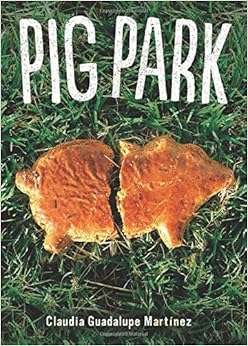In the introduction of Exinct
Lands, Temporal Geographies, Mary Pat Brady claims that space is produced
“in the everyday, in the social,” and as a result, the factors of race, gender,
and sexuality become relevant to the making of space (6). This approach to
space as a social construct upends the notion of it as “the grand manifestation
of natural terrain” (Brady 6). With changing cultural values and social
demographics, space can be modified to reflect the changes society has gone
through. The most prominent of these changes in our society is the
incorporation of a capitalist ideology in our interactions with space.
Claudia Guadalupe Martinez’s Pig Park explores the after effects of capitalism on a town that is
no longer able to produce capital once The American Lard Company, the major
contributor to their economy, relocates to another country. In a desperate
attempt to save their neighborhood from turning into a ghost town, fifteen-year-old
Masi Burciaga and her friends help the adults build a giant pyramid in Pig Park to draw
in tourists.
In true capitalist notion, the people believe that if they
build the pyramid, the visitors will come, and once again their stagnated town
will be invigorated by the capital these tourists will bring. Rather than
seeing the cultural association of the pyramid as a burial monument and
sacrificial platform, the adults only see its symbolism for the capitalist
system, and a symbol of their salvation.
Masi even points out that the people of their neighborhood
“weren’t Egyptians or Aztecs to be building pyramids,” but as one of the adults
states, “[N]o one this side of North America has a pyramid. Building a Gran Pirámide right here is the
opportunity of a lifetime” (Martinez 17). Taking advantage of the lack of a
certain commodity and capitalizing on its production for consumer use has been
the most popular way that people have participated in the reconstruction of
space. Just as the industrial age brought with it the fetishization of
consumerism by making it accessible to more people, here we see the use of a
cultural icon, the pyramid, being used for capitalist purposes for a town and
society that does not have the historical or cultural ties to the creators of
the great pyramids. To them the creation of the pyramid is not about building
an icon of their culture, rather the marketing of a known tourist trap for
their own benefit.
The map Martinez includes in the book shows their town to be
surrounded from all sides by the American Lard Company buildings and railroad,
reminders of the capitalist system that could not perform in this society. When
the big business fails to be successful, so do the small businesses. As the
land is transformed from a successful capitalist hub to a ghost town where
people cannot make a living anymore, we see the transformation of the social
aspect of space. Unable to afford the land that they lease for their
businesses, the strain of the capitalist market seeps its way into the familial
bonds that threaten to break up Masi’s family. As the only existing “natural”
part of the town, Pig Park, is transformed into a shrine to capitalism, it
shows that at the heart of the town, the success of its people will be ever
dependent on the success of business.
As “space and social relations (re)constitute each other,”
we see a different perspective on space as the mere setting for a story, some
background image that is extra to the story rather than a crucial part of the
story as a factor in the socio-cultural makeup of a town. Just as people can
have an effect on space, then space, too, can create a change in people, as the
possibility of a new town attraction brings with it the dangerous capitalist
entrepreneurs that wish to exploit the common people for their company’s
benefit. The ritualistic consumption and recreation of capitalist ideology
shows people’s interpellation to a dominant culture that uses space as a means
to an end.




No comments:
Post a Comment